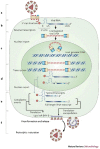Translational control of retroviruses
- PMID: 17224922
- PMCID: PMC7096986
- DOI: 10.1038/nrmicro1599
Translational control of retroviruses
Abstract
All replication-competent retroviruses contain three main reading frames, gag, pol and env, which are used for the synthesis of structural proteins, enzymes and envelope proteins respectively. Complex retroviruses, such as lentiviruses, also code for regulatory and accessory proteins that have essential roles in viral replication. The concerted expression of these genes ensures the efficient polypeptide production required for the assembly and release of new infectious progeny virions. Retroviral protein synthesis takes place in the cytoplasm and depends exclusively on the translational machinery of the host infected cell. Therefore, not surprisingly, retroviruses have developed RNA structures and strategies to promote robust and efficient expression of viral proteins in a competitive cellular environment.
Conflict of interest statement
The authors declare no competing financial interests.
Figures






Similar articles
-
HIV-1 replication.Somat Cell Mol Genet. 2001 Nov;26(1-6):13-33. doi: 10.1023/a:1021070512287. Somat Cell Mol Genet. 2001. PMID: 12465460 Review.
-
Posttranscriptional regulation of retroviral gene expression: primary RNA transcripts play three roles as pre-mRNA, mRNA, and genomic RNA.Wiley Interdiscip Rev RNA. 2013 Sep-Oct;4(5):567-80. doi: 10.1002/wrna.1179. Epub 2013 Jun 10. Wiley Interdiscip Rev RNA. 2013. PMID: 23754689 Free PMC article. Review.
-
Converging strategies in expression of human complex retroviruses.Viruses. 2011 Aug;3(8):1395-414. doi: 10.3390/v3081395. Epub 2011 Aug 11. Viruses. 2011. PMID: 21994786 Free PMC article. Review.
-
Mechanisms employed by retroviruses to exploit host factors for translational control of a complicated proteome.Retrovirology. 2009 Jan 24;6:8. doi: 10.1186/1742-4690-6-8. Retrovirology. 2009. PMID: 19166625 Free PMC article. Review.
-
Retroviral RNA elements integrate components of post-transcriptional gene expression.Life Sci. 2001 Oct 26;69(23):2697-709. doi: 10.1016/s0024-3205(01)01360-1. Life Sci. 2001. PMID: 11720075 Review.
Cited by
-
Gene Therapy Applications of Non-Human Lentiviral Vectors.Viruses. 2020 Sep 29;12(10):1106. doi: 10.3390/v12101106. Viruses. 2020. PMID: 33003635 Free PMC article. Review.
-
HEK293 Cell Line as a Platform to Produce Recombinant Proteins and Viral Vectors.Front Bioeng Biotechnol. 2021 Dec 13;9:796991. doi: 10.3389/fbioe.2021.796991. eCollection 2021. Front Bioeng Biotechnol. 2021. PMID: 34966729 Free PMC article. Review.
-
Two ribosome recruitment sites direct multiple translation events within HIV1 Gag open reading frame.Nucleic Acids Res. 2017 Jul 7;45(12):7382-7400. doi: 10.1093/nar/gkx303. Nucleic Acids Res. 2017. PMID: 28449096 Free PMC article.
-
HTLV-1 Rex Tunes the Cellular Environment Favorable for Viral Replication.Viruses. 2016 Feb 24;8(3):58. doi: 10.3390/v8030058. Viruses. 2016. PMID: 26927155 Free PMC article. Review.
-
Structural domains within the HIV-1 mRNA and the ribosomal protein S25 influence cap-independent translation initiation.FEBS J. 2016 Jul;283(13):2508-27. doi: 10.1111/febs.13756. Epub 2016 Jun 10. FEBS J. 2016. PMID: 27191820 Free PMC article.
References
-
- Telenitsky A, Goff SP. Retroviruses. 1997. pp. 121–160.
-
- Vogt PK. Retroviruses. 1997. pp. 1–25.
-
- Rabson AB, Graves BJ. Retroviruses. 1997. pp. 205–261.
-
- Swanstrom R, Willis JW. Retroviruses. 1997. pp. 263–334.
Publication types
MeSH terms
Substances
LinkOut - more resources
Full Text Sources
Other Literature Sources

